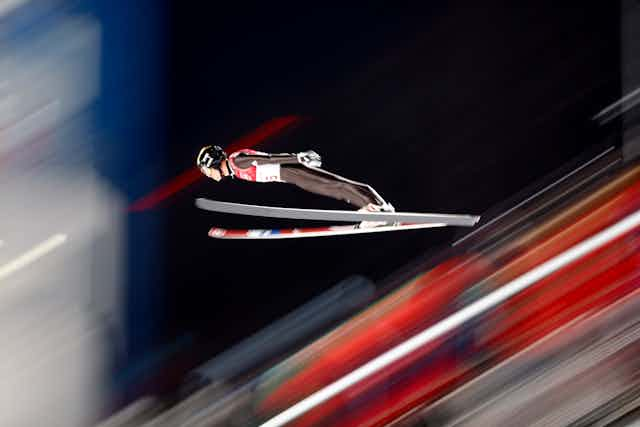One of the main draws of the Winter Olympics is the opportunity to witness some of the most exciting and nail-biting athletic feats.
The daring events include the bobsled and downhill skiing. Then there’s the terrifying skeleton: Imagine barreling down a narrow chute of twisted ice-coated concrete at 125 miles per hour. Now imagine doing that head first, like a human battering ram.
Athletes train for years for these events, but most of these elite athletes possess something that helps them succeed during these high-stakes events: their personality.
Some people have a personality trait that helps them focus in highly chaotic environments like the ones you’ll see during the Winter Olympics. It’s called a high sensation-seeking personality, and it’s a trait that, as a psychologist, I’ve long been fascinated with.
Calm in the face of danger
To some extent, we all crave complex and new experiences – that is, we all seek new sensations.
Whether it’s our attraction to the latest shiny gadget or the newest fashion trend, novelty tugs at us. But even though we all share an interest in new sensations, what sets high sensation-seeking personalities apart is that they crave these exotic and intense experiences to an extent that they’re willing to risk their health.
What’s amazing is that some high sensation-seeking individuals experience less stress and are fearless and calm in the face of danger. For example, 2014 Olympic slalom gold medalist Mikaela Shiffrin tears down mountains at speeds of 80 mph. But she recently told Sky Magazine that the experience can feel like it unfolds in slow motion while she’s “finding a way to control the controllable.”
There’s neurological evidence to back up the sense of calm that athletes like Shiffrin feel in midst of chaos and danger.
You may have heard of cortisol – it’s the “fight or flight” hormone, and it can make us feel stressed and overwhelmed.
However, when people with high sensation-seeking personalities have intense experiences, they don’t produce that much cortisol. On top of that, they produce higher levels of “pleasure” chemicals like dopamine.

What’s more, researchers have found that people with high sensation-seeking personalities have increased sensitivity to things that could be rewarding – like landing a perfect switch backside 1620 – and decreased sensitivity to potential dangers, such as the fear of wiping out after doing a triple jump.
High sensation-seeking isn’t exclusive to Winter Olympians, of course. It can creep into every aspect of life, influencing the way you interact with other people, the things you do for fun, the music you like, the way you drive and even the jokes you tell.
Leaping before you look
In the 1950s, while studying sensory deprivation, psychologist Robert Zuckerman stumbled upon this sensation-seeking trait. Zuckerman was eventually able to show that sensation-seeking is made up of four distinct components.
Each contributes to an individual’s unique way of seeking or avoiding sensation. (And you can actually take a test to see where you fall for each of these four components on the sensation-seeking scale.)
The first two – thrill-seeking and experience-seeking – were mentioned earlier. But the sensation-seeking personality trait also involves disinhibition and boredom susceptibility.
Disinhibition has to do with our willingness to be spontaneous and our ability to let loose. People with low levels of disinhibition always look before they leap. Those high in disinhibition? They just leap.
Boredom susceptibility boils down to your ability to tolerate the absence of external stimuli. Those with high scores in boredom susceptibility dislike repetition: They tire easily of predictable or dull people, and they get restless when forced to perform mundane tasks.
This last component might be the toughest thing for Olympic athletes who are high-sensation seekers to deal with. In order to be a successful Olympian, you need to spend countless hours practicing dull, repetitive workouts and drills.
It’s easy to see how all of these aspects of sensation-seeking personalities might exist in Olympic athletes, whether it’s a snowboarder experimenting with a daring new trick or a hockey forward navigating a puck through a maze of defenders.
People with high sensation-seeking personalities don’t just crave these situations. In those moments, they’re in their element. Where a low sensation-seeking person might crumble, they thrive.
So when you’re watching the Winter Olympics and wondering how the athletes can handle the pressures and dangers of competition, just remember: For some of them, chaos and intensity are secret weapons of success.

